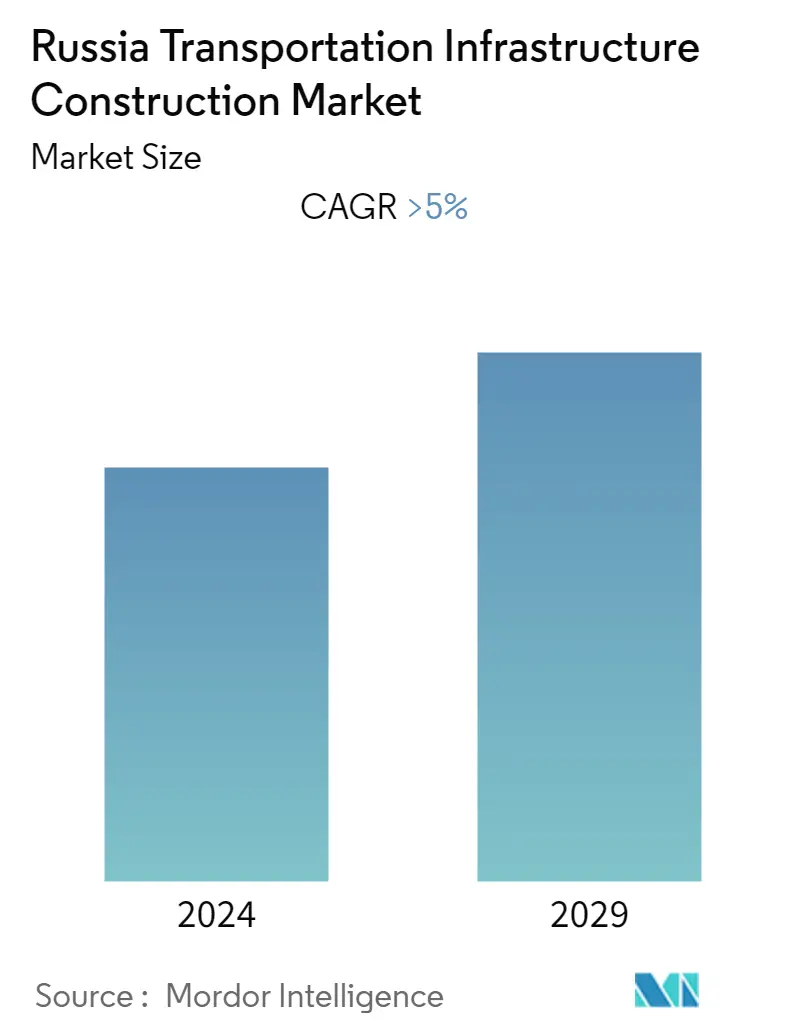Market Size of Russia Transportation Infrastructure Construction Industry

| Study Period | 2020 - 2029 |
| Base Year For Estimation | 2023 |
| Forecast Data Period | 2024 - 2029 |
| Historical Data Period | 2020 - 2022 |
| CAGR | 5.00 % |
| Market Concentration | Medium |
Major Players
*Disclaimer: Major Players sorted in no particular order |
Russia Transportation Infrastructure Construction Market Analysis
Russia's Transportation Infrastructure Construction Market is expected to register a CAGR of more than 5% during the forecast period (2022-2027).
COVID-19 affected the transportation sector, and the impact is directly and indirectly, such as a reduction in transit services, construction slowed down by social distancing factors, affected supply chain, etc. Now the sector is recovering and focusing on developments.
Furthermore, the Russian government is focusing on the modernization of transportation infrastructure. Under a comprehensive plan, RUB 6.3 trillion was issued to revamp the country's highways, airports, railways, ports, and other transportation infrastructure. In addition, the Russian government allocated another RUB 4.8 trillion (USD 66.6 billion) to the "Safe and High-Quality Highways" project. These projects improve the road connectivity of Russia's regions.
However, by 2030, the government plans to install 6,835 miles (11,000 kilometers) of fresh railroad tracks, linking the cities of Moscow, St. Petersburg, Samara, Krasnodar, and Novosibirsk. In addition, the Russian railway network is experiencing robust growth in construction activities under the guidance of rail monopoly RZD (Russian Railways). In 2020, RZD was building 12,427 miles (20,000 kilometers) of new lines, to be completed by 2030 at an estimated cost of more than USD 61 billion.
Russia Transportation Infrastructure Construction Industry Segmentation
Transportation infrastructure construction refers to a wide range of construction activities involving reforming existing constructions, building new infrastructures, and extending or demolishing projects. Furthermore, the Russia Transportation Infrastructure Construction market covers the growing trends, a complete background analysis of the transportation infrastructure construction market, which includes an assessment of the economy and contribution of sectors in the economy, market overview, market size estimation for key segments, and emerging trends in the market segments, market dynamics, and the impact of COVID - 19 on the market are covered in the report.
Russia's Transportation Infrastructure Construction Market is segmented by Mode (Roadways, Railways, Airports, Ports, and Inland Waterways) and Key Cities (Moscow, St. Petersburg, and Kazan). The report offers market size and forecasts for Russia's Transportation Infrastructure Construction Market in value (USD Billion) for all the above segments.
| By Mode | |
| Roadways | |
| Railways | |
| Airports | |
| Ports and Inland Waterways |
| By Key Cities | |
| Moscow | |
| St. Petersburg | |
| Kazan |
Russia Transportation Infrastructure Construction Market Size Summary
The transportation infrastructure construction market in Russia is poised for significant growth, driven by government initiatives aimed at modernization and expansion. The sector is recovering from the disruptions caused by the COVID-19 pandemic, which had led to reduced transit services and slowed construction activities. The Russian government has allocated substantial funds to revamp highways, airports, railways, and ports, with a focus on enhancing regional connectivity and developing strategic routes such as the Europe-Western China corridor and the Northern Sea Route. Key projects include the construction of new railroad tracks and high-speed railways, as well as major road infrastructure developments like the M-12 high-speed highway. These efforts are supported by investments from both domestic and international stakeholders, including significant participation from Chinese investors in the Far East region.
The market is characterized by a moderate level of fragmentation, with major industry players dominating the landscape. Companies such as Mosproekt-3, Russian Highways, and Aecon Group Inc. are leading the charge in infrastructure projects, which include the construction of bridges, flyovers, and other engineering structures. The government's comprehensive modernization plan, coupled with strategic investments, is expected to drive the growth of the transportation infrastructure sector in Russia over the coming years. Despite the challenges posed by the pandemic, the sector is on a path to recovery, with a clear focus on enhancing the country's transportation capabilities and improving connectivity between key cities and regions.
Russia Transportation Infrastructure Construction Market Size - Table of Contents
-
1. MARKET INSIGHTS AND DYNAMICS
-
1.1 Market Overview
-
1.2 Government Regulations and Initiatives
-
1.3 Supply Chain/Value Chain Analysis
-
1.4 Technology Snapshot and Digital Trends
-
1.5 Insights on Modernization of the Transportation Infrastructure Sector in Russia
-
1.6 Insights on Major Infrastructure Development Projects in Russia
-
1.7 Market Dynamics
-
1.7.1 Market Drivers
-
1.7.2 Market Restraints
-
1.7.3 Market Opportunities
-
-
1.8 Porter's Five Forces Analysis
-
1.9 Impact of COVID-19 on the Market
-
-
2. MARKET SEGMENTATION
-
2.1 By Mode
-
2.1.1 Roadways
-
2.1.2 Railways
-
2.1.3 Airports
-
2.1.4 Ports and Inland Waterways
-
-
2.2 By Key Cities
-
2.2.1 Moscow
-
2.2.2 St. Petersburg
-
2.2.3 Kazan
-
-
Russia Transportation Infrastructure Construction Market Size FAQs
What is the current Russia Transportation Infrastructure Construction Market size?
The Russia Transportation Infrastructure Construction Market is projected to register a CAGR of greater than 5% during the forecast period (2024-2029)
Who are the key players in Russia Transportation Infrastructure Construction Market?
Mosproekt-3, Russian highways, Aecon Group Inc., ENKA and AO Institute Stroyproekt are the major companies operating in the Russia Transportation Infrastructure Construction Market.

